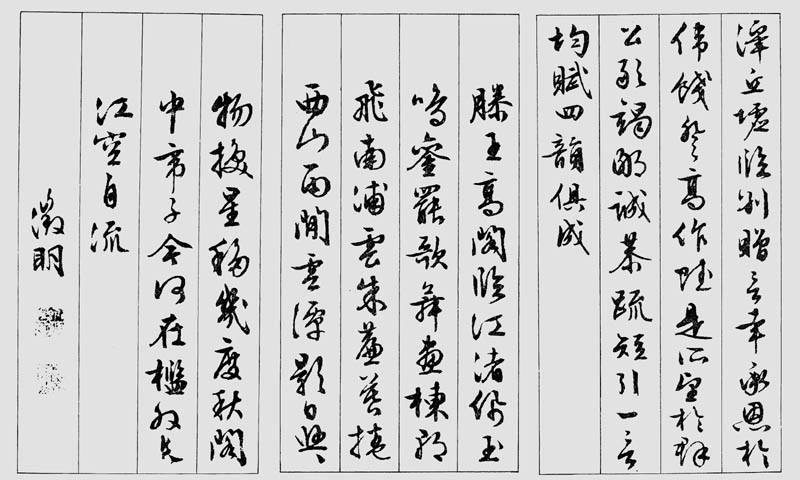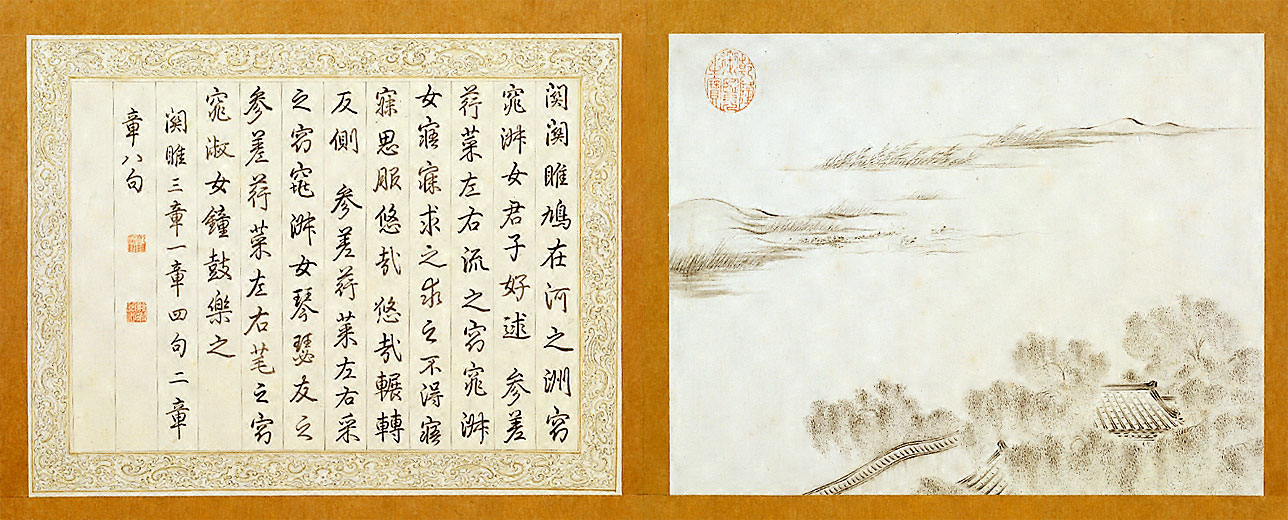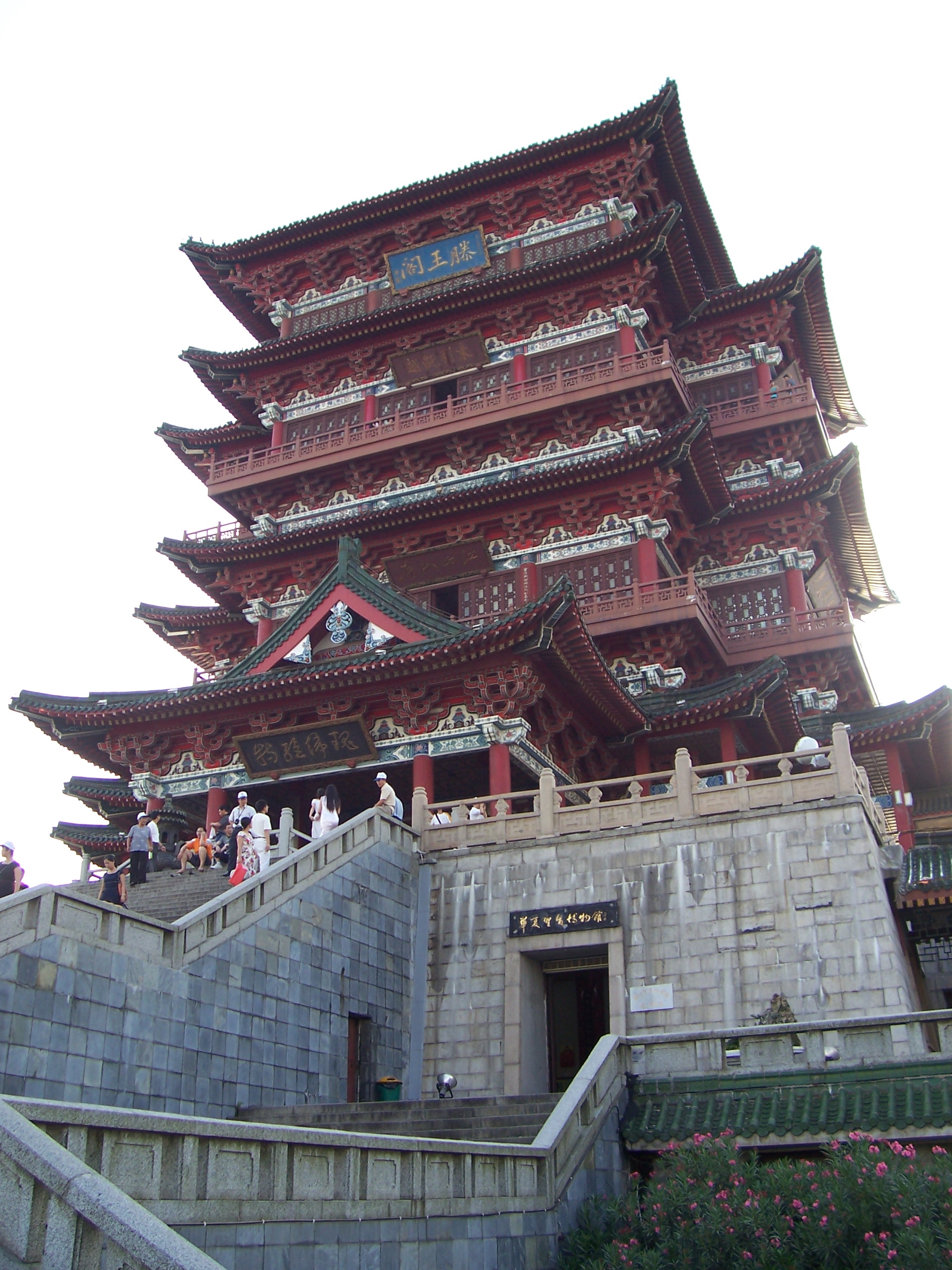|
Tengwang Ge Xu
''Tengwang Ge Xu'' ( zh, t=滕王閣序, p=Téngwáng Gé Xù, ''Preface to the Prince Teng's Pavilion''), full name ''Preface to a Farewell Feast Atop the Prince Teng's Pavilion in Autumn'' ( zh, t=秋日登洪府滕王閣餞別序, p=Qiūrì Dēng Hóng Fǔ Téngwáng Gé Jiànbié Xù) or ''Preface to Poems on the Prince of Teng's Pavilion'' ( zh, t=滕王閣詩序, p=Téngwáng Gé Shī Xù), is a masterpiece of parallel prose by Wang Bo (poet), Wang Bo of the Tang dynasty. Some of the lines in this preface are widely known among the Chinese readers, such as “The glowing clouds at sunset fly away with a lonely egret ;The autumnal waters merge with the broad sky in one fading color.” It is classified as pianwen ( zh, s=駢文, p=Piánwén), which depends greatly on rhythm, somewhat like classical Chinese poetry, but does not have a restriction of how many characters should be in one sentence, and how many sentences in one paragraph. It is named after Pavilion of Prince Teng ... [...More Info...] [...Related Items...] OR: [Wikipedia] [Google] [Baidu] |
Wang Bo (poet)
Wang Bo (; 650–676), courtesy name Zi'an (子安), was a Chinese poet during Tang dynasty, traditionally grouped together with Luo Binwang, Lu Zhaolin, and Yang Jiong as the Four Paragons of the Early Tang. He died at the age of 26, possibly from drowning, while going back from the Tang-ruled Jiaozhi after meeting his father. He opposed the spread of the Gong Ti Style (宫体诗风) of the Sui dynasty, and advocated a style rich in emotions. He was most well-known for his parallel prose work '' Tengwang Ge Xu'', which is included in the Chinese middle school curriculum. Life Wang Bo was born in A.D 650 into a family with high literary status. His grandfather was the Sui dynasty Confucian philosopher Wang Tong. His father was named Wang Fuzhi (王福畤). According to the ''Old Book of Tang'', Wang Bo could write poems when he was six years old; he finished reading the Classics when he was ten. Beginning his career under Prince Pei ( Prince Zhanghuai), he wrote a ... [...More Info...] [...Related Items...] OR: [Wikipedia] [Google] [Baidu] |
Tang Dynasty
The Tang dynasty (, ; zh, c=唐朝), or the Tang Empire, was an Dynasties of China, imperial dynasty of China that ruled from 618 to 907, with an Wu Zhou, interregnum between 690 and 705. It was preceded by the Sui dynasty and followed by the Five Dynasties and Ten Kingdoms period. Historians generally regard the Tang as a high point in Chinese civilisation, and a Golden age (metaphor), golden age of cosmopolitan culture. Tang territory, acquired through the military campaigns of its early rulers, rivalled that of the Han dynasty. The House of Li, Li family founded the dynasty after taking advantage of a period of Sui decline and precipitating their final collapse, in turn inaugurating a period of progress and stability in the first half of the dynasty's rule. The dynasty was formally interrupted during 690–705 when Empress Wu Zetian seized the throne, proclaiming the Wu Zhou dynasty and becoming the only legitimate Chinese empress regnant. The An Lushan rebellion (755 ... [...More Info...] [...Related Items...] OR: [Wikipedia] [Google] [Baidu] |
Pianwen
Pianwen ( zh, s=骈文, t=駢文, p=piánwén, l=parallel writing, c=, first=t) is a highly stylised prose style, prevalent throughout the history of Chinese literature. Its prominent features lie in its regular lines arranged in couplets; in its early history, these lines were mostly of either four or six characters, and so pianwen are also known as Four-Six Prose (). While the pianwen form was frequently utilised in official writings, or in describing scenery, its tight restrictions in metrical, tonal and thematic terms restricted its literary development. Subsequent movements, such as the Classical Prose Movement, were a response to these restrictions, but pianwen would continue to be written until the end of the Imperial Chinese era and the widespread use of vernacular Chinese in writing. Name According to the ''Shuowen Jiezi'', the word ''pian'' (), with a horse radical and the character for 'aligned, in line', originally referred to a two-horse carriage where the horses ... [...More Info...] [...Related Items...] OR: [Wikipedia] [Google] [Baidu] |
Classical Chinese Poetry
Classical Chinese poetry is traditional Chinese poetry written in Classical Chinese and typified by certain traditional forms, or modes; traditional genres; and connections with particular historical periods, such as the poetry of the Tang dynasty. The existence of classical Chinese poetry is documented at least as early as the publication of the ''Classic of Poetry'' (''Shijing''). Various combinations of forms and genres have developed over the ages. Many or most of these poetic forms were developed by the end of the Tang dynasty, in 907 CE. The use and development of Classical Chinese poetry actively continued up until the May Fourth Movement, in 1919, and is still developed even today. Poetry created during this period of more-or-less continuous development displays a great deal of diversity – categorized by both major historical periods and by dynastic periods (the traditional Chinese historical method). Another key aspect of Classical Chinese poetry is its intense i ... [...More Info...] [...Related Items...] OR: [Wikipedia] [Google] [Baidu] |
Pavilion Of Prince Teng
The Pavilion of Prince Teng () is a building in the North West of the city of Nanchang, in Jiangxi province, China, on the east bank of the Gan River and is one of the Three Great Towers of southern China. The other two are the Yueyang Tower and the Yellow Crane Pavilion. It has been destroyed and rebuilt many times over its history. The present building was rebuilt in 1989 on the original site. The rebuilding plan was devised by the architect Liang Sicheng, and now the Pavilion of Prince Teng is the landmark of Nanchang. There are nine floors in total. The main architectural structure is in Song dynasty wooden style, showing the magnificence of the Pavilion. History The Pavilion of Prince Teng was first built in 653 AD, by Li Yuanying, the younger brother of Emperor Taizong of Tang and uncle of Emperor Gaozong of Tang. Li Yuanying was enfeoffed as Prince Teng in 639 and spent his early years in Suzhou. In 652 he was assigned the governorship of Nanchang where the pavilion se ... [...More Info...] [...Related Items...] OR: [Wikipedia] [Google] [Baidu] |
Gan River
The Gan River (, Gan: Kōm-kong) runs north through the western part of Jiangxi before flowing into Lake Poyang and thus the Yangtze River. The Xiang-Gan uplands separate it from the Xiang River of neighboring eastern Hunan. Two similarly sized rivers, the Gong River which is the southern tributary and the Mei River from the north combine in Yudu County, Jiangxi, to form the Gan. The Gan River flows before splitting into distributaries just north of Nanchang. The longest of these, the North Branch, is several times longer than the other distributaries at . The Gan River is the major geographical feature of Jiangxi, and gives its name to the Gan variety of Chinese as well as the province's one-character abbreviation. The river feeds into Lake Poyang, which in turns connects with the Yangtze The Yangtze or Yangzi ( or ) is the longest river in Eurasia and the third-longest in the world. It rises at Jari Hill in the Tanggula Mountains of the Tibetan Plateau and flow ... [...More Info...] [...Related Items...] OR: [Wikipedia] [Google] [Baidu] |
Nanchang
Nanchang is the capital of Jiangxi, China. Located in the north-central part of the province and in the hinterland of Poyang Lake Plain, it is bounded on the west by the Jiuling Mountains, and on the east by Poyang Lake. Because of its strategic location connecting the prosperous East China, East and South China, South China, it has become a major railway hub in Southern China in recent decades. As the Nanchang Uprising in 1927 is distinctively recognized by the ruling Chinese Communist Party, Communist Party as "firing the first gunshot against the Kuomintang, Nationalists", the current government has therefore named the city since 1949 "the place where the People's Liberation Army was born", and the most widely known "place where the military banner of the People's Liberation Army was first raised". Nanchang is also a major city, appearing among the top 100 List of cities by scientific output, cities in the world by scientific research outputs, as tracked by the Nature Inde ... [...More Info...] [...Related Items...] OR: [Wikipedia] [Google] [Baidu] |
Jiangxi
; Gan: ) , translit_lang1_type2 = , translit_lang1_info2 = , translit_lang1_type3 = , translit_lang1_info3 = , image_map = Jiangxi in China (+all claims hatched).svg , mapsize = 275px , map_caption = Location of Jiangxi in China , coordinates = , subdivision_type = Country , subdivision_name = China , named_for = Jiangnanxi Circuit () , seat_type = Capital , seat = Nanchang , seat1_type = Largest city , seat1 = Ganzhou , parts_type = Divisions , parts_style = para , p1 = 11 prefectures , p2 = 99 counties , p3 = 1549 townships , government_type = Province , governing_body = Jiangxi Provincial People's Congress , leader_title = Party Secretary , leader_name = Yin Hong , leader_title1 = Congress chairman , leader_name1 = Yin Hong , leader_title2 = Governor ... [...More Info...] [...Related Items...] OR: [Wikipedia] [Google] [Baidu] |
Tonkin
Tonkin, also spelled Tongkin, Tonquin or Tongking, is an exonym referring to the northern region of Vietnam. During the 17th and 18th centuries, this term referred to the domain '' Đàng Ngoài'' under Trịnh lords' control, including both the Northern and Thanh- Nghệ regions, north of the Gianh River. From 1884 to early 1945, this term was used for the French protectorate of Tonkin, composed of only the Northern region. Names "Tonkin" is a Western rendition of 東京 ''Đông Kinh'', meaning 'Eastern Capital'. This was the name of the capital of the Lê dynasty (present-day Hanoi). Locally, Tonkin is nowadays known as ''miền Bắc'', or ''Bắc Bộ'', meaning ' Northern Region'. The name was used from 1883 to 1945 for the French protectorate of Tonkin (Vietnamese: ''Bắc Kỳ'' 北圻), a constituent territory of French Indochina. Geography It is south of Yunnan (Vân Nam) and Guangxi (Quảng Tây) Provinces of China; east of northern Laos and west of the Gulf of T ... [...More Info...] [...Related Items...] OR: [Wikipedia] [Google] [Baidu] |






